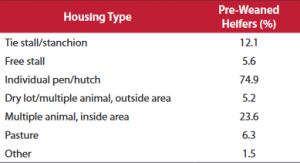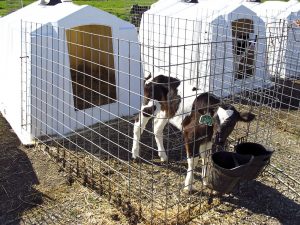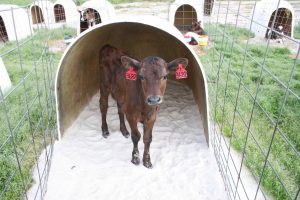In the study of 115 dairy farms in Quebec, calves were housed individually in 87.9% of herds and inappropriate housing methods such as crates were used in 27.0% of herds and tie-stalls in 13.9% of herds. The majority of pre-weaned dairy calves in the US are reared in individual hutches according to USDA 2010 dairy report as shown in the table.

In North America, outdoor hutches are the most common type of housing for calves. Hutches are typically four-sided pens made of fiberglass, polyethylene or wood. They may be attached to an outside run so they can choose between indoor or outdoor space, however, this space is often inadequate for physical exercise as calves have very minimal space. The Canadian Dairy Code of Practice states that housing for calves must allow them to easily stand up, lie down, turn around, exhibit normal resting postures and see other calves. The outside space is either fenced or calves are tethered to the hutches.


In a majority of dairy farms, calves typically spend about 90 days in individual hutches before being moved to group housing where they can socialize. In the European Union, group housing is mandatory for calves older than 8 weeks. Individual calf-housing is advantageous in that it allows individual monitoring of health and behavior, feed intake can be controlled and consumption monitored and spread of disease can be reduced. Disadvantages include being more labor intensive to keep calves in hutches and welfare issues associated with natural living and affective states that we will discuss next.
